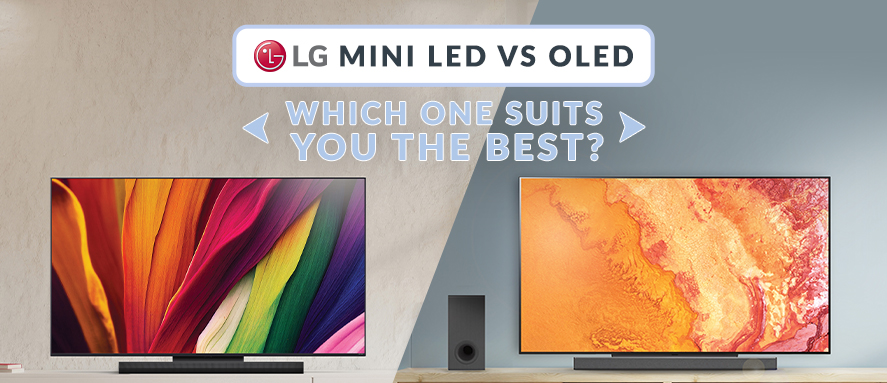LG’s OLED vs QNED MiniLED

Searching for a new LG Smart TV? We compare LG’s OLED TV and QNED MiniLed TV technologies to help you find your perfect TV!
OLED and QNED MiniLED are both TV display technologies aiming for superior picture quality, but they differ in how they achieve it.
OLED uses self-lit pixels that can be individually turned on or off for perfect blacks and vibrant colours. On the other hand, QNED MiniLED uses tiny LEDs behind the screen, divided into zones for better contrast, but blacks aren't as deep as OLED due to the backlight required in the TV’s panel.
Essentially, OLED offers superior contrast and colour accuracy, while QNED MiniLED excels in brightness.
Yes, QNED MiniLED TVs are generally brighter than OLED TVs. This is because MiniLEDs use a backlight system with multiple zones that can be independently controlled, allowing for higher brightness levels. LG QNED MiniLED TVs also boast threefold benefits from its 3 technologies: Quantum Dot technology, NanoCell technology and Mini LEDs. OLEDs, on the other hand, rely on self-illuminating pixels, which typically have lower peak brightness.
OLED TVs generally offer a superior cinematic experience. Their perfect blacks, infinite contrast, and wide viewing angles deliver an immersive atmosphere. Meanwhile QNED MiniLED TVs have improved contrast compared to traditional LED TVs, they still fall short of OLED's depth and accuracy. However, if you prioritise peak brightness and a larger screen size, QNED MiniLED might be a suitable option.
Both Samsung QLED and LG QNED are high-quality TVs offering impressive picture quality. However, they have distinct characteristics. Samsung QLED focuses on bright, vibrant colours and wide viewing angles, while LG QNED prioritizes deep blacks and contrast through MiniLED technology, bringing it closer to OLED performance. Ultimately, the best choice depends on your viewing preferences. If you prioritise brightness and colour pop, Samsung’s QLED TVs might be ideal, but if you desire superior contrast and a cinematic experience, LG’s QNED TV could be the better option.
When choosing between OLED and QNED MiniLED, consider these factors:
- Picture quality: OLED excels in contrast, black levels, and colour accuracy, while QNED MiniLED offers improved contrast over traditional LED but can't match OLED's depth.
- Brightness: QNED MiniLED typically offers higher peak brightness, making it better for bright rooms, while OLED has improved in brightness but might struggle in very sunny environments
- Viewing angles: OLED offers wider viewing angles than QNED MiniLED.
- Budget: OLED TVs generally have a higher price point compared to QNED MiniLED.





